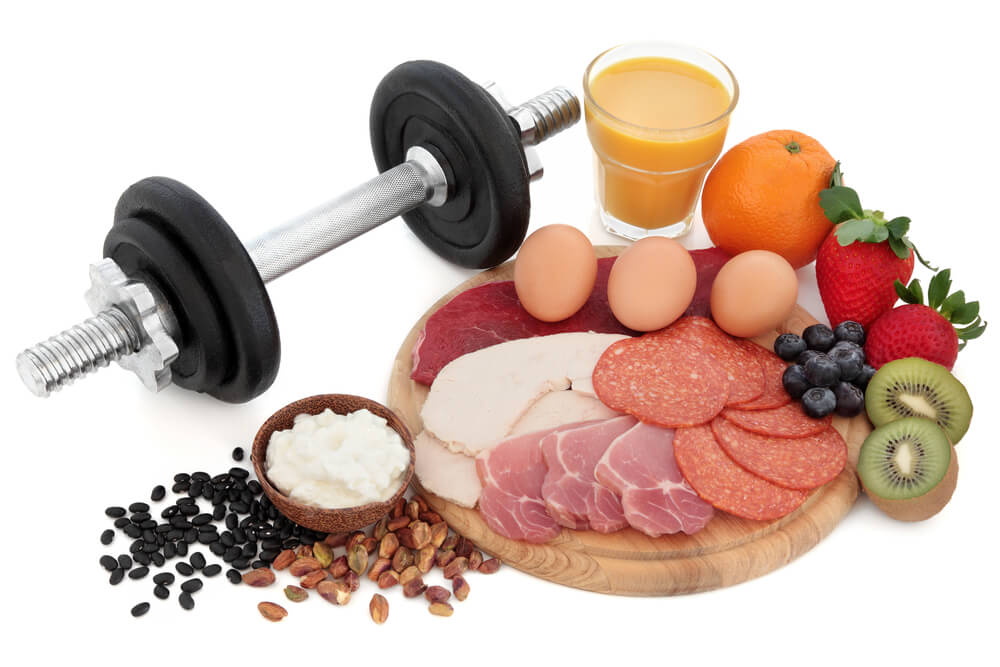
Think you know all there is to know about building muscle? Think again. We break it all down. From the terms to the must-haves, it’s all right here. You’re welcome! Here is Hypertrophy…
Muscle growth is the goal of any lifter, whether it’s for aesthetic reasons, athletic performance, to powerlifting (get stronger) or just for the hell of it. Muscle growth has been shown to enhance all these goals of exercise through many media.
That includes bodybuilding shows over the years (aesthetic goals), research (athletic performance), powerlifting competitions (powerlifters are lifting heavier than ever and records are constantly being broken) and the jargon of all the lifting bros in your gym that are always talking about getting a big chest and biceps.
Hypertrophy Definition: The Terms
When it comes to terminology surrounding muscle growth, there are two words commonly thrown around seemingly haphazardly: Hypertrophy and hyperplasia. Hyperplasia means the creation of new muscle fibers.
If you took a cross section of a muscle of someone experiencing hyperplasia before and after an extended (let’s say 12-week) exercise program, you would see many more muscle fibers in the after cross-section than the before cross section. But, the research shows that humans do not experience this; it’s only been shown to happen in cats.
If you’re interested, it’s the big cats like lions and tigers that experience hyperplasia.
Seeing as you’re reading this right now, you’re most likely not a cat unless scientists have figured out how to teach cats English (which wouldn’t be that surprising considering how smart some of them are). In fact, I’m quite confident you aren’t a cat, which brings us to term number two, which is the only way humans can account for any increase in their muscle size: Hypertrophy.
In contrast to hyperplasia, hypertrophy is the increase in cross-sectional area of the individual muscle fibers. You’re not increasing the number of fibers and muscle cells as is the case with big cats undergoing hyperplasia, just the size of the individual fibers themselves. This means bigger muscles as the end result.
Think of it like the balloons you see people making balloon animals out of. When there is little to no air in them, they’re small and look thin.
When they get filled with air they get bigger and look thicker.

The Proteins Involved
In muscles, the air that fills them is comprised of a couple of different proteins, namely actin and myosin.
Those two proteins are responsible for a muscle’s pulling power, so increasing the amount of them in a muscle means the muscle gets bigger because the proteins occupy space, so each muscle cell needs to get bigger to house the increased amount of protein, and because all the muscle cells need to get bigger, the muscle itself increases in size. Also, more pulling power from increased muscular cross-sectional area (bigger muscles) has the added benefit of increasing strength.
Now that we’ve been over the sciencey stuff, it’s time for the fun part: How to do it. Talk to any good strength coach, or in this case even a researcher, and you’ll learn that there are three ways to increase muscle size and strength. They are to lift heavy, accelerate light loads and to induce a large amount of muscular tension.
We’ll focus on lifting heavy.

Building Size And Strength By Lifting Heavy
When it comes to lifting heavy, there is not an arbitrary number placed on what the word heavy means with regards to a weight you lift in the gym. Instead, heavy implies a percentage of your one-repetition max (1RM) that will induce a positive training response, meaning lifting a weight that will make your muscles grow as a response to training.
Scientists, through many years of testing and experiments, have figured out that 55% (or more) of your 1RM is the magic number that will, after lifting it enough times depending on the percentage, induce that positive training response.
Now it’ time for another quick lesson in biology and how it applies to what you do in the gym. To force change in muscles, specifically to make them bigger, you need to damage them. The damage is temporary, and you know you’ve done it right when you get sore.
The more intramuscular damage you cause, the better.
How do you do that?
Simple: High volume, meaning lots of sets and reps of a given exercise or group of exercises that work on the same muscle, or lots of time under tension (time the muscle spends working).
Let’s Talk About Volume First
Ever seen a bodybuilder train?
They split their training by body part. For example, Monday will be chest, Tuesday will be back, Wednesday they’ll train their shoulders, Thursday will be legs and Friday will be arms, or something like that.
Why?
This is because, on a given day, all the time they spend in the gym will be dedicated to one muscle group.
Imagine doing chest for an hour at the pace a bodybuilder works. If you can do one set of 10 push-ups every two minutes (which is pretty realistic), that’s 300 push-ups in an hour or 600 in two. That’s a lot and will make you very sore. However, push-ups don’t use enough weight to make an avid lifter really feel it.
Yes, we addressed that 55% 1RM is the magic number, but that’s just a starting point. The average well-trained person (which you likely are if you’re on this website) can lift 55% of their 1RM in the neighborhood of 20 times. That is why volume-oriented workouts revolve around 70 to 75% of your 1RM, which you should be able to lift 8 to 12 times. More reps means more intramuscular damage. That’s why you perform a high number of sets.
Here’s a sample bodybuilding-style, hour-long workout for chest:
Bench Press 5×10
Incline Dumbbell Press 5×10
Pec-Deck Flye 5×10
Decline Dumbbell Flye 5×10
Incline Cable Flye-Press Combo 5×10
Low Cable Crossover 5×10
Close-Grip Bench Press 5×10
Dumbbell Pullover 5×10
That’s 400 reps spent working on your chest alone, with a weight that is a hell of lot heavier than what you’d be using doing a push-up, relatively speaking. You can assume 70% of your bodyweight is what you’d be effectively performing a bench press with if you’re doing a push-up. For a 200-pound man, that’s 140 pounds.
Pretty damn light for five sets of 10 reps. So clearly, the volume of work done in a sample bodybuilding day is a lot, and that’s not including extras that bodybuilders commonly do, like drop sets or supersets.
Don’t Forget Tempo
The other way to use lifting heavy to your advantage is to train with tempo. The theory that drives this training strategy is to increase the time a muscle spends working.
The average set of 10 reps of a given exercise takes about 10 to 15 seconds to complete. Imagine taking that amount of time to do one rep, then doing nine more. Granted, you’d have to lift a bit lighter than the 70 to 75% of your 1RM to complete a tempo-based workout, but you’d cause the same amount, if not more, intramuscular damage as with a volume based workout.
The goal for each set of an exercise in a tempo-based workout is to reach at least 30 seconds of time under tension. My recommendation is to do this during the eccentric (lowering) phase of each move, because, according to research, eccentric contraction (seems counterintuitive but bear with me, it’s a term used by the best strength coaches and researchers in the world) is 60% more effective than concentric contraction (the kind of contraction occurring when lifting a weight) at causing intramuscular damage.
I recommend a four to five-second lowering phase, a slight pause at the bottom of the motion, then lifting it as fast as you can. Using this method, six to eight reps should do the trick of making a given muscle work for 30+ seconds. Here’s a sample tempo workout for chest:
Directions: Take five seconds to lower the weight, pause for one second then lift the weight as fast as you can. Perform the prescribed reps, rest two minutes and repeat for the given number of sets.
Bench Press 5×6
Incline Dumbbell Press 4×8
Low Cable Crossover 4×8
Single-Arm Decline Press 4×8
And that’s all you need when working with tempo. It would take you the same amount of time as a volume-oriented muscle building workout so depending on the kind of pace you like to move at, this might be more your speed (no pun intended). A volume-based workout will make you sweat more than a tempo-based workout, but the response to the training will be the same. At the start, the soreness will be debilitating (but will become more bearable over time) and your muscles will heal back bigger and stronger as a response to the training.

Nutrition Is Vital
I wouldn’t be able to forgive myself if I didn’t talk about nutrition when it comes to growing.
Why?
Proper nutrition supplies you with the building blocks and the energy to build the proteins that comprise muscle, actin, and myosin. I will also address supplementation.
When it comes to protein, you’ll hear bodybuilders and fitness gurus (not sure about the guru status) talk about consuming an amount of protein in comparison to the number of pounds of body weight you have. Most often, these people will recommend two grams of protein for every pound of bodyweight. That’s a lot of food.
If you are a 200-pound man, you would have to eat 32 ounces (that’s 2 pounds) of chicken per day to meet that goal. That should only comprise around 30% of your diet, the next 20% should be dietary fats and the last 50% should be carbs.
No, carbs are not the enemy. They are required (at least 130 grams per day) for your nervous system (the primary determinant of strength, and you can’t be big without being strong) to function properly.
But, if you talk to a good strength and conditioning coach or nutritionist, they’ll suggest that this recommendation will definitely have you consuming way more calories than you need and point to the research. Research has shown that consuming 1.5 grams of protein for every kilogram of bodyweight is more than enough to achieve muscle growth and won’t have you consuming more calories than you need for optimal muscle growth.
But where do fats fit into the equation?
To build one pound of muscle, you need to consume 1,825 more calories than you burn (from all activities, including eating, sleeping, walking, working, etc.) in one week. That’s how much energy it takes to synthesize one pound of muscle protein. Fat is your friend for muscle growth, as it is your most energy-rich nutrient. It provides you with nine calories for every gram you consume, as compared to four from each gram of protein or carbs you eat.
When it comes to supplementation, there are a few supplements outside of protein that experts agree help when building muscle. Branched-chain amino acids (usually sold in powder form) that have a leucine to isoleucine and valine (different amino acids; they are the building blocks that make up proteins) ratio of 2:1:1 have shown to be effective in building muscle.
Leucine activates a process in the body called the mTOR (for all you science nerds out there, that stands for Mechanistic Target Of Rapamycin) pathway that increases the rate of protein synthesis in your muscles. In short, that pathway helps you build muscle faster.
Another huge benefit of leucine supplementation is that HMB (again for the science nerds, HMB stands for beta-hexa beta-methyl butyric acid) is a byproduct of the breakdown of leucine. HMB is a very powerful catabolic inhibitor. In other words, it stops your muscles from eating themselves and using the resulting amino acids for energy. You can also obtain extra HMB from supplements, usually sold in pill form.

Conclusion
So there you have it, many different ways to achieve hypertrophy, or build more muscle. It’s up to you to try everything and decide what works best for you, but all these methods have been evaluated by the eggheads and all of those strength training protocols, nutrition strategies and supplements will work if your goal is to be the biggest bear in the gym, or even if you just want to add an inch to your arms to impress your significant other or that cutie behind the desk that smiles and tells you to enjoy your workout as she hands you a towel. You’re welcome and happy lifting!
You’re welcome and happy lifting!
By Michael Schletter, CSCS*D, NSCA-CPT*D
Latest posts by Terry M (see all)
- Garage Gyms - Aug 1, 2018
- Kettlebells – Why They Should Be Added To Your Routine. - Jul 24, 2018
- Weight Belts: What Are They Really For? - May 31, 2018









Great post!
All my training has always been centred around 3 sets of each exercise. I can see that I need to up my game and do more sets. That might explain why I always have had problems building muscle! I’m looking forward to seeing how that change will affect my muscle mass in 4-5 weeks.
Jakob,
Thanks for stopping by and glad you got some great tips from the article!
Good luck with your lifts
Terry Asher
[…] are a lot of hypertrophy programs which use linear periodization. In each, linear periodization’s foundation is applied in […]
[…] of lifting heavy weights for maximum hypertrophy, some of the world’s most impressive younger lifters have simply adopted lightweight exercises […]
[…] of lifting heavy weights for maximum hypertrophy, some of the world’s most impressive younger lifters have simply adopted lightweight exercises […]
[…] term “muscle pump” is basically the common way of referring to transient hypertrophy, which literally means the temporary growth of muscles in the human […]
[…] term “muscle pump” is basically the common way of referring to transient hypertrophy, which literally means the temporary growth of muscles in the human […]
[…] term “muscle bomb” is basically the usual way of referring to transients hypertrophy, which literally means the temporary growth of the muscles of the human […]
[…] term “muscle pump” is basically the common way of referring to transient hypertrophy, which literally means the temporary growth of muscles in the human […]
[…] term “muscle pump” is essentially the typical method of describing short-term hypertrophy, which actually suggests the momentary development of muscles in the […]
[…] term “muscle pump” is basically the common way of referring to transient hypertrophy, which literally means the temporary growth of muscles in the human […]
[…] has tremendous value too. This depends on the goal of the workout, and whether you are training for hypertrophy, metabolic or strength […]
[…] de-load, you can take the training in many different directions. You can repeat the cycle or do a hypertrophy phase for […]
[…] de-load, you can take the training in many different directions. You can repeat the cycle or do a hypertrophy phase for […]
[…] de-load, you can take the training in many different directions. You can repeat the cycle or do a hypertrophy phase for […]
My workouts have always revolved around performing three sets of each activity. Clearly, I need to step up my game and perform more sets. Maybe that’s why I’ve never been able to bulk up properly! In about a month and a half, I’ll get to see what effect that shift has on my muscle mass.
Can someone tell me when is the most effective abs workout?
[…] position is one of the most surefire ways to cause mechanical damage. This can be great for hypertrophy training, but is usually not what we go for when we do metabolic […]
[…] de-load, you can take the training in many different directions. You can repeat the cycle or do a hypertrophy phase for […]